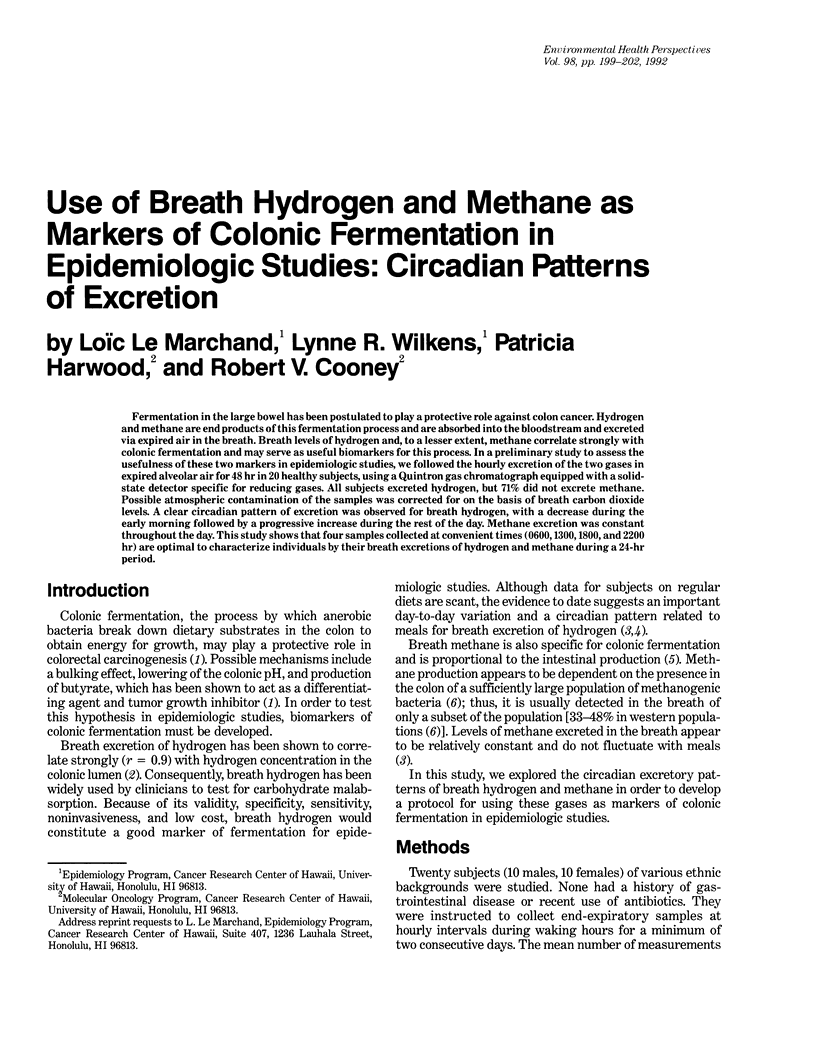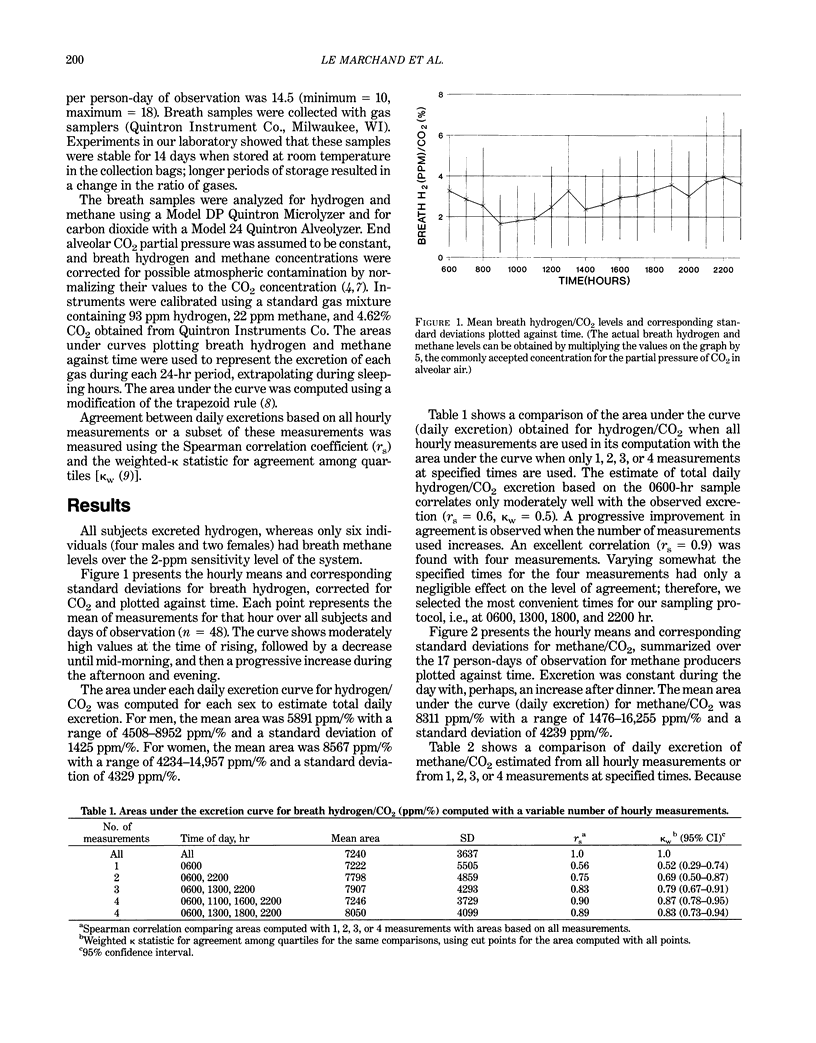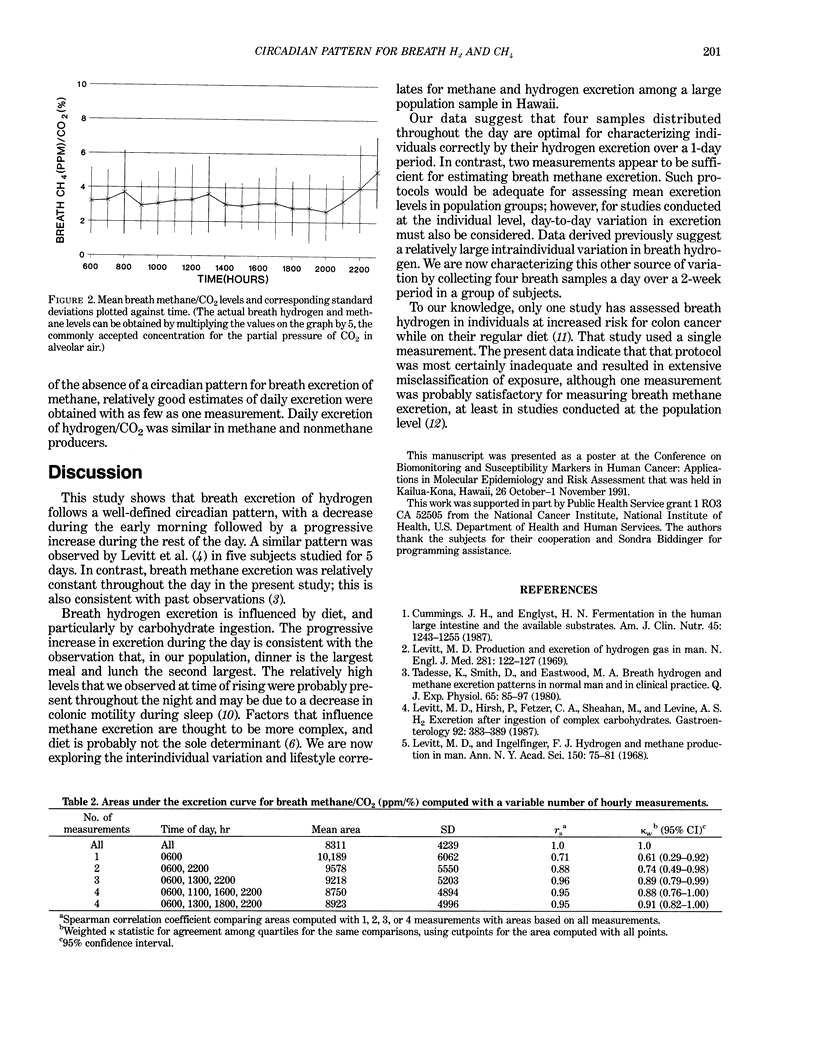Abstract
Fermentation in the large bowel has been postulated to play a protective role against colon cancer. Hydrogen and methane are end products of this fermentation process and are absorbed into the bloodstream and excreted via expired air in the breath. Breath levels of hydrogen and, to a lesser extent, methane correlate strongly with colonic fermentation and may serve as useful biomarkers for this process. In a preliminary study to assess the usefulness of these two markers in epidemiologic studies, we followed the hourly excretion of the two gases in expired alveolar air for 48 hr in 20 healthy subjects, using a Quintron gas chromatograph equipped with a solid-state detector specific for reducing gases. All subjects excreted hydrogen, but 71% did not excrete methane. Possible atmospheric contamination of the samples was corrected for on the basis of breath carbon dioxide levels. A clear circadian pattern of excretion was observed for breath hydrogen, with a decrease during the early morning followed by a progressive increase during the rest of the day. Methane excretion was constant throughout the day. This study shows that four samples collected at convenient times (0600, 1300, 1800, and 2200 hr) are optimal to characterize individuals by their breath excretions of hydrogen and methane during a 24-hr period.
Full text
PDF



Selected References
These references are in PubMed. This may not be the complete list of references from this article.
- Cummings J. H., Englyst H. N. Fermentation in the human large intestine and the available substrates. Am J Clin Nutr. 1987 May;45(5 Suppl):1243–1255. doi: 10.1093/ajcn/45.5.1243. [DOI] [PubMed] [Google Scholar]
- Levitt M. D., Hirsh P., Fetzer C. A., Sheahan M., Levine A. S. H2 excretion after ingestion of complex carbohydrates. Gastroenterology. 1987 Feb;92(2):383–389. doi: 10.1016/0016-5085(87)90132-6. [DOI] [PubMed] [Google Scholar]
- Levitt M. D., Ingelfinger F. J. Hydrogen and methane production in man. Ann N Y Acad Sci. 1968 Feb 26;150(1):75–81. doi: 10.1111/j.1749-6632.1968.tb19033.x. [DOI] [PubMed] [Google Scholar]
- Levitt M. D. Production and excretion of hydrogen gas in man. N Engl J Med. 1969 Jul 17;281(3):122–127. doi: 10.1056/NEJM196907172810303. [DOI] [PubMed] [Google Scholar]
- Niu H. C., Schoeller D. A., Klein P. D. Improved gas chromatographic quantitation of breath hydrogen by normalization to respiratory carbon dioxide. J Lab Clin Med. 1979 Nov;94(5):755–763. [PubMed] [Google Scholar]
- Segal I., Walker A. R., Lord S., Cummings J. H. Breath methane and large bowel cancer risk in contrasting African populations. Gut. 1988 May;29(5):608–613. doi: 10.1136/gut.29.5.608. [DOI] [PMC free article] [PubMed] [Google Scholar]
- Solomons N. W., Viteri F., Rosenberg I. H. Development of an interval sampling hydrogen (H2) breath test for carbohydrate malabsorption in children: evidence for a circadian pattern of breath H2 concentration. Pediatr Res. 1978 Aug;12(8):816–823. doi: 10.1203/00006450-197808000-00002. [DOI] [PubMed] [Google Scholar]
- Tadesse K., Smith D., Eastwod M. A. Breath hydrogen (H2) and methane (CH4) excretion patterns in normal man and in clinical practice. Q J Exp Physiol Cogn Med Sci. 1980 Apr;65(2):85–97. doi: 10.1113/expphysiol.1980.sp002502. [DOI] [PubMed] [Google Scholar]


